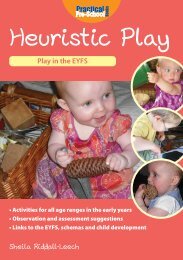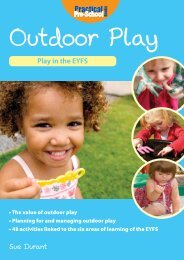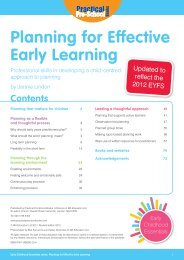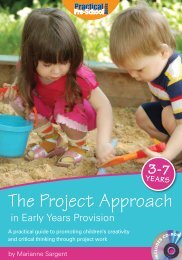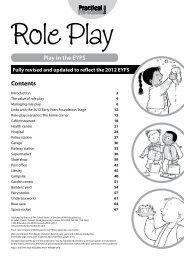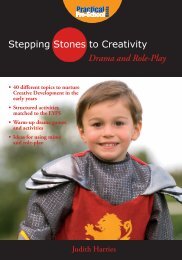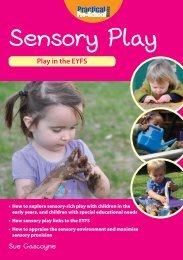Sustained Shared Thinking - Practical Pre-School Books
Sustained Shared Thinking - Practical Pre-School Books
Sustained Shared Thinking - Practical Pre-School Books
Create successful ePaper yourself
Turn your PDF publications into a flip-book with our unique Google optimized e-Paper software.
Helm and Katz (2001) explain that rather than give children<br />
information, practitioners should give them time and space<br />
to obtain it for themselves. Practitioners can help with this by<br />
facilitating discussion, encouraging children to talk together<br />
and ask questions of each other as well as adults. This involves<br />
asking open questions, a difficult skill that takes time and<br />
practice to develop. For examples of open questions, see the<br />
prompt card on an investigation area below. It can be made<br />
easier by including question ideas on planning and observation<br />
documents. It is also a good idea to display reminders around<br />
the learning environment that will serve as prompts for all<br />
practitioners. This can be done in the following ways:<br />
Display open questions both inside and outside<br />
These serve as prompts for practitioners who are seeking to<br />
develop a conversation with a child in order to help further<br />
their thinking. The questions are intended to act as inspiration<br />
for practitioners, who need only glance up for a moment to<br />
get an idea about what to ask next. They also serve as useful<br />
prompts for additional adults such as students, parents and<br />
support staff, who might be new to the setting.<br />
Create sustained shared thinking cards<br />
It is also helpful to display cards that promote sustained<br />
shared thinking in each area of provision within the setting.<br />
These cards have suggestions for open-ended questions and<br />
useful key words that can be introduced into conversation. In<br />
addition, the cards might highlight where such activities fit<br />
into the curriculum.<br />
Set up informative displays<br />
Informative displays set at the children’s eye level are also an<br />
effective way to prompt discussion. Such displays might feature<br />
posters or photographs with snippets of information and questions<br />
about the project theme. These displays can be used to provide<br />
information and stimulate conversation about a subject. Helm<br />
and Katz (2001) suggest also mounting children’s questions for<br />
investigation in the relevant areas of provision around the setting.<br />
Reflect with the children<br />
Display photographs of the children taken while they were<br />
involved in their investigations. These photographs can be<br />
captioned with questions or observation notes and quotations<br />
An example of a sustained shared thinking card for the investigation area<br />
4<br />
Using projects to promote sustained shared thinking by Marianne Sargent - Author of The Project Approach in Early Years Provision




